问题提出
有如下需求,保证 account.withdraw 取款方法的线程安全
java
interface Account {
// 获取余额
Integer getBalance();
// 取款
void withdraw(Integer amount);
static void demo(Account account) {
List<Thread> ts = new ArrayList<>();
long start = System.nanoTime();
for (int i = 0; i < 1000; i++) {
ts.add(new Thread(() -> {
account.withdraw(10);
}));
}
ts.forEach(Thread::start);
ts.forEach(t -> {
try {
t.join();
} catch (InterruptedException e) {
throw new RuntimeException(e);
}
});
long end = System.nanoTime();
System.out.println(account.getBalance() + " cost: " + (end-start)/1000_000 + " ms");
}
}原有实现并不是线程安全的
java
class AccountUnsafe implements Account {
private Integer balance;
public AccountUnsafe(Integer balance) {
this.balance = balance;
}
@Override
public Integer getBalance() {
return balance;
}
@Override
public void withdraw(Integer amount) {
balance -= amount;
}
}执行测试
java
class TestAccount {
public static void main(String[] args) {
AccountUnsafe accountUnsafe = new AccountUnsafe(1000);
Account.demo(accountUnsafe);
}
}执行结果
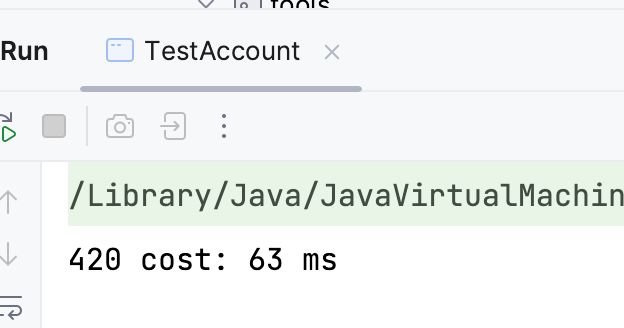
同时有多个线程并发对变量 balance 进行操作,产生线程安全问题
解决思路-锁
首先想到的是给 Account 对象加锁
java
class AccountUnsafe implements Account {
private Integer balance;
public AccountUnsafe(Integer balance) {
this.balance = balance;
}
@Override
public synchronized Integer getBalance() {
return balance;
}
@Override
public synchronized void withdraw(Integer amount) {
balance -= amount;
}
}加锁后执行结果
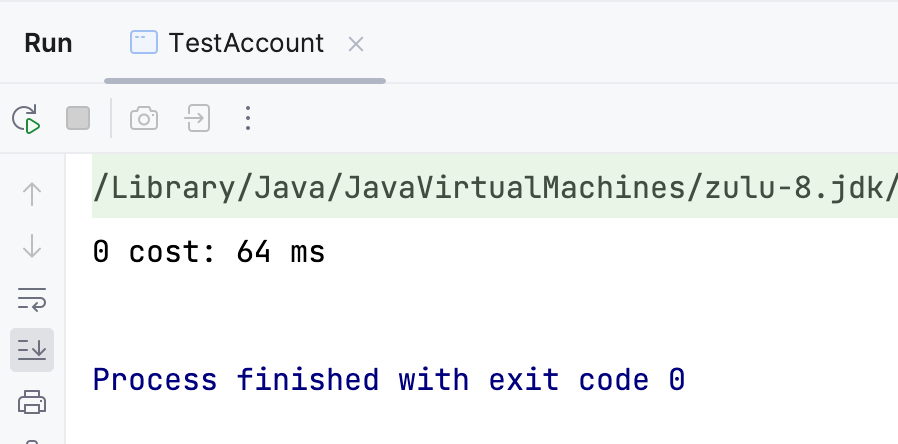
解锁思路-无锁
java
class AccountSafe implements Account {
private AtomicInteger balance;
public AccountSafe(AtomicInteger balance) {
this.balance = balance;
}
@Override
public Integer getBalance() {
return balance.get();
}
@Override
public void withdraw(Integer amount) {
while(true) {
int prev = balance.get();
int next = prev - amount;
if (balance.compareAndSet(prev, next)) {
break;
}
}
}
}测试代码
java
class TestAccount {
public static void main(String[] args) {
AccountUnsafe accountUnsafe = new AccountUnsafe(10000);
AccountSafe accountSafe = new AccountSafe(new AtomicInteger(10000));
Account.demo(accountUnsafe);
Account.demo(accountSafe);
}
}执行结果
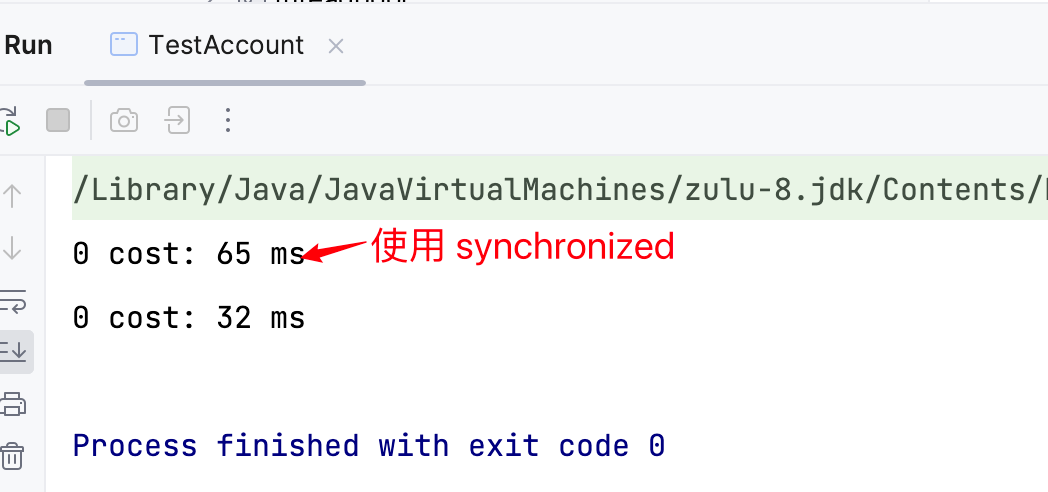
CAS 与 volatile
前面看到的 AtomicInteger 的解决方法,内部并没有用锁来保护共享变量的线程安全。那么它是如何实现的呢?
java
public void withdraw(Integer amount) {
// 需要不断尝试,直到成功为止
while(true) {
// 比如拿到了旧值 1000
int prev = balance.get();
// 在这个基础上 1000 - 10 = 990
int next = prev - amount;
/*
* compareAndSet 正式做这个检查的,在 set 前,先比较 prev 与当前值
* 不一致了,next 作废,返回 false 表示失败
* 比如,别的线程已经做了减法,当前值已经被减成了 990
* 那么本线程的这次 990 就作废了,进入 while 下次循环重试
* 一致,以 next 设置为新值,返回 true 表示成功
*/
if (balance.compareAndSet(prev, next)) {
break;
}
}
}其中的关键是 compareAndSet,它的简称就是 CAS (也有 Compare And Swap 的说法),它必须是原子操作。
:::tips
**注意 **
其实 CAS 的底层是 lock cmpxchg 指令(X86 架构),在单核 CPU 和多核 CPU 下都能够保证【比较-交换】的原子性
- 在多核状态下,某个核执行到带 lock 的指令时,CPU 会让总线锁住,当这个核把此指令执行完毕,再开启总线。这个过程中不会被线程的调度机制所打断,保证了多个线程对内存操作的准确性,是原子 的。
:::
volatile
获取共享变量时,为了保证该变量的可见性,需要使用 volatile 修饰。
它可以用来修饰成员变量和静态成员变量,可以避免线程从自己的工作缓存中查找变量的值,必须到主存中获取它的值,线程操作 volatile 变量都是直接操作主存,即一个线程对 volatile 变量的修改,对另一个线程可见。
:::tips
注意:
volatile 仅仅保证了共享变量的可见性,让其他线程能看到最新值,但不能解决指令交错问题(不能保证原子性)
:::
CAS 必须借助 volatile 才能读取到共享变量的最新值来实现【比较并交换】的效果。
为什么无锁效率高
- 无锁情况下,即使重试失败,线程始终在高速运行,没有停歇2,而 synchronized 会让线程在没有获得锁的时候,发生上下文切换,进入阻塞,打个比喻:线程就好像告诉跑道上的赛车,高速运行时,速度超快,一旦发生上下文切换,就好比赛车要减速、熄火,等被唤醒又得重新打火、启动、加速...恢复到高速运行,代价比较大
- 但无锁情况下,因为线程要保持运行,需要额外 CPU 的支持,CPU 在这里就好比高速跑道,没有额外的跑道,线程想高速运行也无从谈起,虽然不会进入阻塞,但由于没有分到时间片,仍然会进入可运行状态,还是会导致上下文切换。
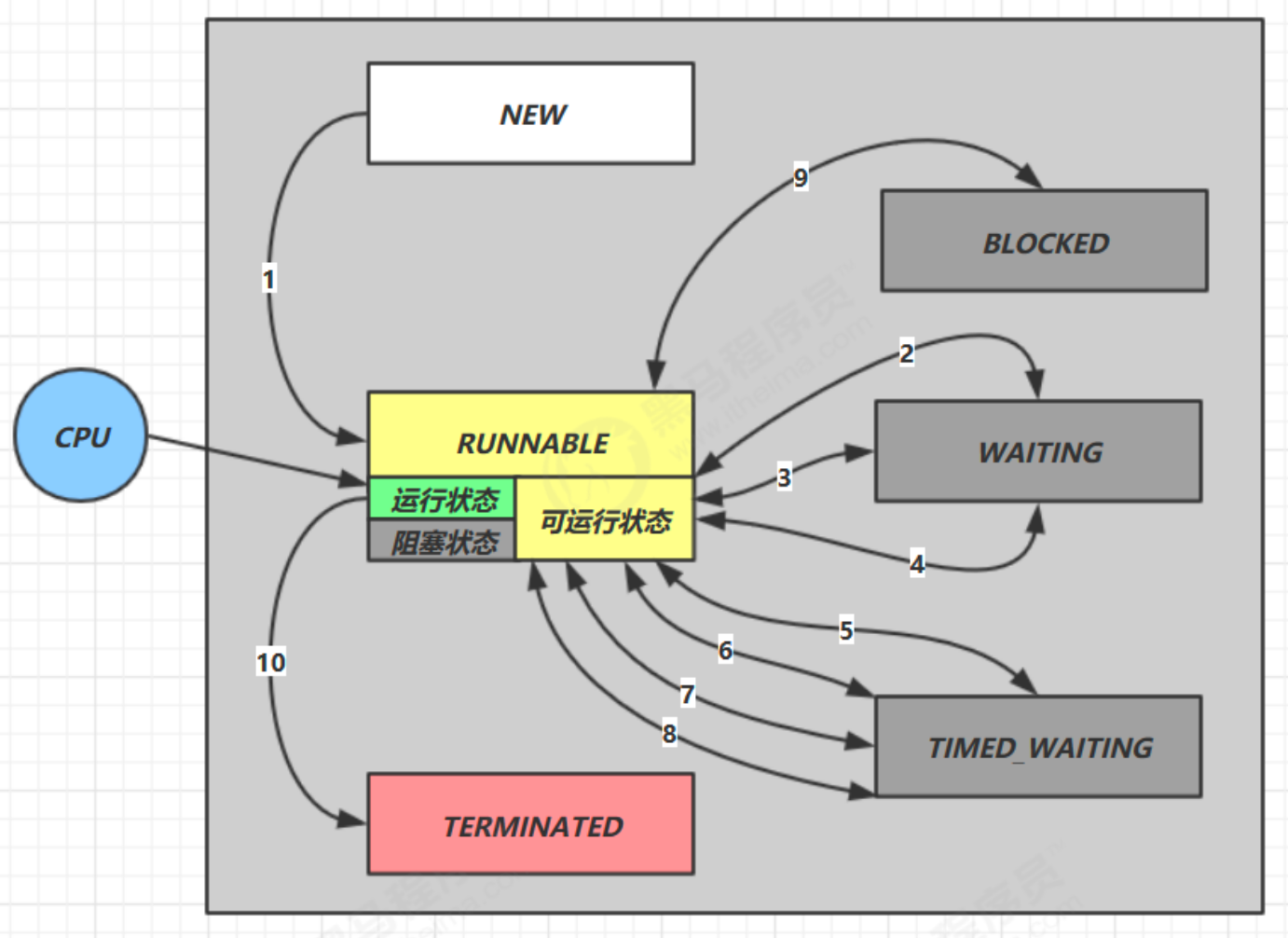
CAS 的特点
结合 CAS 和 volatile 可以实现无锁并发,适用于线程数少、多核 CPU 的场景下。
- CAS 是基于乐观锁的思想:最乐观的估计,不怕别的线程来修改共享变量,就算改了也没关系,我吃亏点再重试呗。
- synchronized 是基于悲观锁的思想:最悲观的估计,得防着其它线程来修改共享变量,我上了锁你们都别想改,我改完了解开锁,你们才有机会。
- CAS 体现的是无锁并发、无阻塞并发
- 因为没有使用 synchronized,所以线程不会陷入阻塞,这是效率提升的因素之一
- 但如果竞争激烈,可以想到重试必然频繁发生,反而效率会受影响
原子整数
J.U.C 并发包提供了:
- AtomicBoolean
- AtomicInteger
- AtomicLong
以 AtomicInteger 为例:
java
AtomicInteger i = new AtomicInteger(0);
// 获取并自增(i = 0, 结果 i = 1, 返回 0),类似于 i++
System.out.println(i.getAndIncrement());
// 自增并获取(i = 1, 结果 i = 2, 返回 2),类似于 ++i
System.out.println(i.incrementAndGet());
// 自减并获取(i = 2, 结果 i = 1, 返回 1),类似于 --i
System.out.println(i.decrementAndGet());
// 获取并自减(i = 1, 结果 i = 0, 返回 1),类似于 i--
System.out.println(i.getAndDecrement());
// 获取并加值(i = 0, 结果 i = 5, 返回 0)
System.out.println(i.getAndAdd(5));
// 加值并获取(i = 5, 结果 i = 0, 返回 0)
System.out.println(i.addAndGet(-5));
// 获取并更新(i = 0, p 为 i 的当前值, 结果 i = -2, 返回 0)
// 其中函数中的操作能保证原子,但函数需要无副作用
System.out.println(i.getAndUpdate(p -> p - 2));
// 更新并获取(i = -2, p 为 i 的当前值, 结果 i = 0, 返回 0)
// 其中函数中的操作能保证原子,但函数需要无副作用
System.out.println(i.updateAndGet(p -> p + 2));
// 获取并计算(i = 0, p 为 i 的当前值, x 为参数1, 结果 i = 10, 返回 0)
// 其中函数中的操作能保证原子,但函数需要无副作用
// getAndUpdate 如果在 lambda 中引用了外部的局部变量,要保证该局部变量是 final 的
// getAndAccumulate 可以通过 参数1 来引用外部的局部变量,但因为其不在 lambda 中因此不必是 final
System.out.println(i.getAndAccumulate(10, (p, x) -> p + x));
// 计算并获取(i = 10, p 为 i 的当前值, x 为参数1, 结果 i = 0, 返回 0)
// 其中函数中的操作能保证原子,但函数需要无副作用
System.out.println(i.accumulateAndGet(-10, (p, x) -> p + x));原子引用
为什么需要原子引用类型?
- AtomicReference
- AtomicMarkableReference
- AtomicStampedReference
有如下方法:
java
public interface DecimalAccount {
// 获取余额
BigDecimal getBalance();
// 取款
void withdraw(BigDecimal amount);
static void demo(DecimalAccount account) {
List<Thread> ts = new ArrayList<>();
for (int i = 0; i < 1000; i++) {
ts.add(new Thread(() -> {
account.withdraw(BigDecimal.TEN);
}));
}
ts.forEach(Thread::start);
ts.forEach(t -> {
try {
t.join();
} catch (InterruptedException e) {
throw new RuntimeException(e);
}
});
System.out.println(account.getBalance());
}
}使用 CAS 锁实现安全的取款操作
java
class DecimalAccountCas implements DecimalAccount {
private AtomicReference balance;
public DecimalAccountCas(BigDecimal balance) {
this.balance = new AtomicReference(balance);
}
@Override
public BigDecimal getBalance() {
return (BigDecimal) balance.get();
}
@Override
public void withdraw(BigDecimal amount) {
while(true) {
BigDecimal prev = getBalance();
BigDecimal next = prev.subtract(amount);
if(balance.compareAndSet(prev, next)) {
break;
}
}
}
}测试
java
class TestDecimalAccountCas {
public static void main(String[] args) {
DecimalAccount.demo(new DecimalAccountCas(new BigDecimal("10000")));
}
}输出结果:
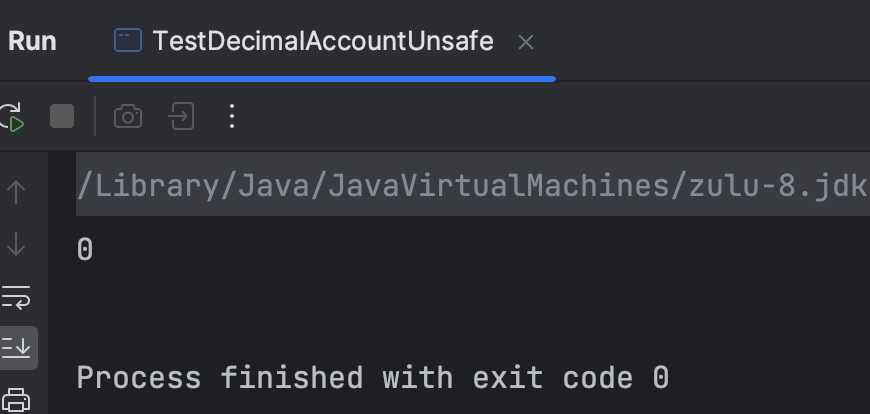
ABA 问题及解决
AtomicReference
java
@Slf4j(topic = "c.TestABA")
public class TestABA {
static AtomicReference<String> ref = new AtomicReference<>("A");
public static void main(String[] args) {
log.debug("main start...");
// 获取值 A
String prev = ref.get();
other();
sleep(1000);
// 尝试改为 C
log.debug("change A->C, {}", ref.compareAndSet(prev, "C"));
}
private static void other() {
new Thread(() -> {
log.debug("change A->B, {}", ref.compareAndSet(ref.get(), "B"));
}, "t1").start();
sleep(500);
new Thread(() -> {
log.debug("change B->A, {}", ref.compareAndSet(ref.get(), "A"));
}, "t2").start();
}
private static void sleep(long time) {
try {
Thread.sleep(time);
} catch (InterruptedException e) {
throw new RuntimeException(e);
}
}
}输出:
java
21:34:33.971 [main] - main start...
21:34:33.997 [t1] - change A->B, true
21:34:34.503 [t2] - change B->A, true
21:34:35.508 [main] - change A->C, true主线程仅能判断出共享变量的值与最初值 A 是否相同,不能感知到这种从 A 改为 B 又改回 A 的情况,如果主线程希望:只要有其他线程【动过了】共享变量,那么自己的 CAS 计算失败,这时,仅比较值是不够的,需要再加一个版本号。
AtomicStampedReference
java
@Slf4j(topic = "c.TestABA")
public class TestABA {
static AtomicStampedReference<String> ref = new AtomicStampedReference<>("A", 0);
public static void main(String[] args) {
log.debug("main start...");
// 获取值 A
String prev = ref.getReference();
int stamp = ref.getStamp();
log.debug("版本 {}", stamp);
other();
sleep(1000);
// 尝试改为 C
log.debug("change A->C, {}", ref.compareAndSet(prev, "C", stamp, stamp + 1));
}
private static void other() {
new Thread(() -> {
log.debug("change A->B, {}", ref.compareAndSet(ref.getReference(), "B", ref.getStamp(), ref.getStamp() + 1));
}, "t1").start();
log.debug("更新版本为 {}", ref.getStamp());
sleep(500);
new Thread(() -> {
log.debug("change B->A, {}", ref.compareAndSet(ref.getReference(), "A", ref.getStamp(), ref.getStamp() + 1));
}, "t2").start();
log.debug("更新版本为 {}", ref.getStamp());
}
private static void sleep(long time) {
try {
Thread.sleep(time);
} catch (InterruptedException e) {
throw new RuntimeException(e);
}
}
}输出为:
java
22:06:25.993 [main] - main start...
22:06:25.994 [main] - 版本 0
22:06:26.022 [t1] - change A->B, true
22:06:26.022 [main] - 更新版本为 0
22:06:26.528 [t2] - change B->A, true
22:06:26.528 [main] - 更新版本为 1
22:06:27.533 [main] - change A->C, falseAtomicStampedReference 可以给原子引用加上版本号,追踪原子应用整个的变化过程,如:A -> B -> A -> C,通过 AtomicStampedReference,我们可以知道,引用变量中途被更改了几次。
但是有时候,并不关心引用变量更改了几次,只是单纯的关心是否更改过,所以就有了 AtomicMakableReference。
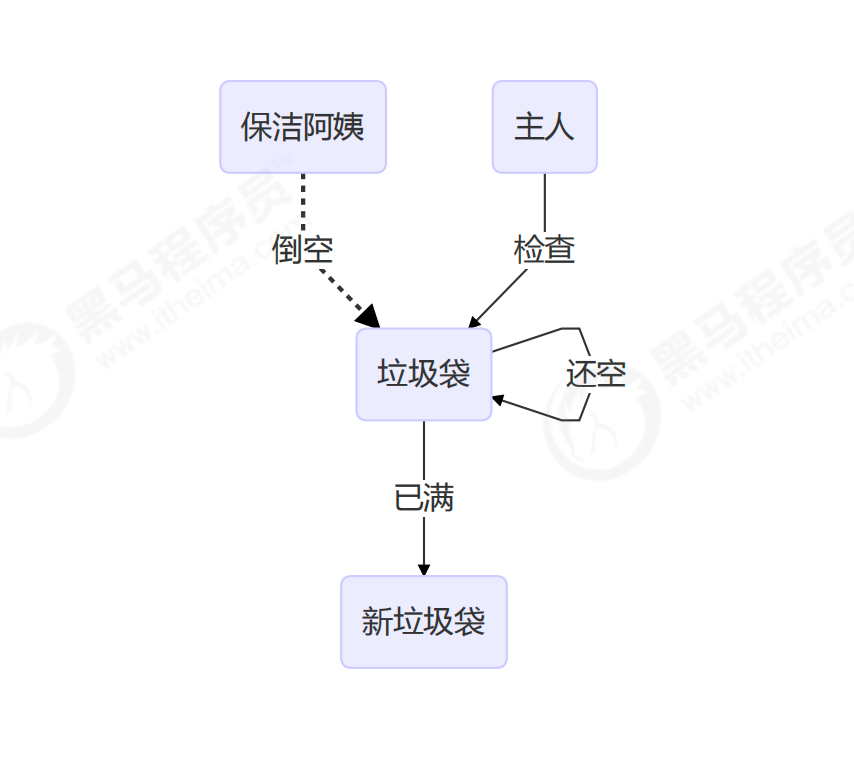
AtomicMakableReference
java
@Slf4j(topic = "c.TestABAAtomicMarkableReference")
public class TestABAAtomicMarkableReference {
public static void main(String[] args) throws InterruptedException {
GarbageBag bag = new GarbageBag("装满垃圾了");
AtomicMarkableReference<GarbageBag> ref = new AtomicMarkableReference<>(bag, true);
log.debug("main start...");
GarbageBag prev = ref.getReference();
log.debug(prev.toString());
new Thread(() -> {
log.debug("打扫卫生的线程 start...");
bag.setDesc("空垃圾袋");
ref.compareAndSet(bag, bag, true, false);
log.debug(bag.toString());
}, "保洁阿姨").start();
Thread.sleep(1000);
log.debug("想换一只新垃圾袋?");
boolean success = ref.compareAndSet(prev, new GarbageBag("空的垃圾袋"), true, false);
log.debug("换了么?" + success);
log.debug(ref.getReference().toString());
}
}
class GarbageBag {
String desc;
public GarbageBag(String desc) {
this.desc = desc;
}
public void setDesc(String desc) {
this.desc = desc;
}
@Override
public String toString() {
return "GarbageBag{" +
"desc='" + desc + '\'' +
'}';
}
}输出结果:
java
22:43:40.296 [main] - main start...
22:43:40.297 [main] - GarbageBag{desc='装满垃圾了'}
22:43:40.322 [保洁阿姨] - 打扫卫生的线程 start...
22:43:40.322 [保洁阿姨] - GarbageBag{desc='空垃圾袋'}
22:43:41.327 [main] - 想换一只新垃圾袋?
22:43:41.328 [main] - 换了么?false
22:43:41.328 [main] - GarbageBag{desc='空垃圾袋'}注释掉打扫卫生线程代码,再观察输出
java
22:45:29.014 [main] - main start...
22:45:29.015 [main] - GarbageBag{desc='装满垃圾了'}
22:45:30.017 [main] - 想换一只新垃圾袋?
22:45:30.017 [main] - 换了么?true
22:45:30.017 [main] - GarbageBag{desc='空的垃圾袋'}**原子数组 **
- AtomicIntegerArray
- AtomicLongArray
- AtomicReferenceArray
有如下方法:
java
public class Test27 {
/**
参数1,提供数组、可以是线程不安全数组或线程安全数组
参数2,获取数组长度的方法
参数3,自增方法,回传 array, index
参数4,打印数组的方法
*/
// supplier 提供者 无中生有 ()->结果
// function 函数 一个参数一个结果 (参数)->结果 , BiFunction (参数1,参数2)->结果
// consumer 消费者 一个参数没结果 (参数)->void, BiConsumer (参数1,参数2)->
private static <T> void demo(Supplier<T> arraySupplier,
Function<T, Integer> lengthFunc,
BiConsumer<T, Integer> putConsumer,
Consumer<T> printConsumer) {
List<Thread> ts = new ArrayList<>();
T array = arraySupplier.get();
int length = lengthFunc.apply(array);
for (int i = 0; i < length; i++) {
ts.add(new Thread(() -> {
for (int j = 0; j < 10000; j++) {
putConsumer.accept(array, j % length);
}
}));
}
ts.forEach(t -> t.start());
ts.forEach(t -> {
try {
t.join();
} catch (InterruptedException e) {
throw new RuntimeException(e);
}
});
printConsumer.accept(array);
}
public static void main(String[] args) {
// 不安全的数组
System.out.print("不安全的数组:");
demo(
() -> new int[10],
array -> array.length, // 此处通过泛型确定 Fuction 接口中的 T 为 int 型数组
(array, index) -> array[index]++,
array -> System.out.println(Arrays.toString(array))
);
// 安全的数组
System.out.print("安全的数组:");
demo(
() -> new AtomicIntegerArray(10),
array -> array.length(), // 此处通过泛型确定 Fuction 接口中的 T 为 int 型数组
(array, index) -> array.getAndIncrement(index),
array -> System.out.println(array)
);
}
}输出结果:
java
不安全的数组:[9131, 9043, 9256, 9288, 9221, 9231, 9212, 9212, 9199, 9225]
安全的数组:[10000, 10000, 10000, 10000, 10000, 10000, 10000, 10000, 10000, 10000]字段更新器
- AtomicReferenceFieldUpdater // 域字段
- AtomicIntegerFieldUpdater
- AtomicLongFieldUpdater
利用字段更新器,可以针对对象的某个域(Field)进行原子操作,只能配合 volatile 修饰的字段使用,否则会出现异常:
java
Exception in thread "main" java.lang.IllegalArgumentException: Must be volatile type
java
public class Test40 {
public static void main(String[] args) throws InterruptedException {
Student stu = new Student();
AtomicReferenceFieldUpdater updater =
AtomicReferenceFieldUpdater.newUpdater(Student.class, String.class, "name");
new Thread(() -> {
stu.name = "李四";
}).start();
Thread.sleep(1000);
System.out.println(updater.compareAndSet(stu, null, "张三"));
System.out.println(stu);
}
}
class Student {
volatile String name;
@Override
public String toString() {
return "Student{" +
"name='" + name + '\'' +
'}';
}
}输出:
java
false
Student{name='李四'}原子累加器
累加器性能比较
java
public class Test41 {
private static <T> void demo(Supplier<T> addSupplier, Consumer<T> action) {
T adder = addSupplier.get();
long start = System.nanoTime();
List<Thread> ts = new ArrayList<>();
for (int i = 0; i < 4; i++) {
ts.add(new Thread(() -> {
for (int j = 0; j < 500000; j++) {
action.accept(adder);
}
}));
}
ts.forEach(t -> t.start());
ts.forEach(t -> {
try {
t.join();
} catch (InterruptedException e) {
throw new RuntimeException(e);
}
});
long end = System.nanoTime();
System.out.println(adder + " cost:" + (end - start)/1000_000);
}
}比较 AtomicLong 与 LongAdder
java
public static void main(String[] args) {
System.out.println("累加器 LongAdder:");
for (int i = 0; i < 5; i++) {
demo(() -> new LongAdder(), adder -> adder.increment());
}
System.out.println("--------------------------------");
System.out.println("累加器 AtomicLong:");
for (int i = 0; i < 5; i++) {
demo(() -> new AtomicLong(), adder -> adder.getAndIncrement());
}
}输出
java
累加器 LongAdder:
2000000 cost:14
2000000 cost:14
2000000 cost:4
2000000 cost:4
2000000 cost:5
--------------------------------
累加器 AtomicLong:
2000000 cost:33
2000000 cost:26
2000000 cost:27
2000000 cost:27
2000000 cost:25性能提升的原因很简单,就是在有竞争时,设置多个累加单元,Thread-0 累加 Cell[0],而 Thread-1 累加 Cell[1]...最后将结果汇总。这样它们在累加时操作的不同的 Cell 变量,因为减少了 CAS 重试失败,从而提高性能。
源码之 LongAdder
LongAdder 类有几个关键域
java
// 累加单元数组,懒惰初始化
transient volatile Cell[] cells;
// 基础值,如果没有竞争,则用 cas 累加这个域
transient volatile long base;
// 在 cells 创建或扩容时,置为 1,表示加锁
transient volatile int cellBusy;cas 锁
java
// 不要用于实践!!!
public class LockCas {
private AtomicInteger state = new AtomicInteger(0);
public void lock() {
while (true) {
if (state.compareAndSet(0, 1)) {
break;
}
}
}
public void unlock() {
log.debug("unlock...");
state.set(0);
}
}测试
java
LockCas lock = new LockCas();
new Thread(() -> {
log.debug("begin...");
lock.lock();
try {
log.debug("lock...");
sleep(1);
} finally {
lock.unlock();
}
}, "t1").start();
new Thread(() -> {
log.debug("begin...");
lock.lock();
try {
log.debug("lock...");
} finally {
lock.unlock();
}
}, "t2").start();输出
java
18:27:07.198 c.Test42 [t1] - begin...
18:27:07.202 c.Test42 [t1] - lock...
18:27:07.198 c.Test42 [t2] - begin...
18:27:08.204 c.Test42 [t1] - unlock...
18:27:08.204 c.Test42 [t2] - lock...
18:27:08.204 c.Test42 [t2] - unlock...原理之伪共存
其中 Cell 即为累加单元
java
abstract class Striped64 extends Number {
// 防止缓存行伪共享
@sun.misc.Contended
static final class Cell {
volatile long value;
Cell(long x) {
value = x;
}
// 最重要的方法, 用 cas 方式来进行累加, cmp 表示旧值, val 表示新值
final boolean cas(long cmp, long val) {
return UNSAFE.compareAndSwapLong(this, valueOffset, cmp, val);
}
// 省略不重要代码
}
}得从缓存说起
缓存与内存的速度比较
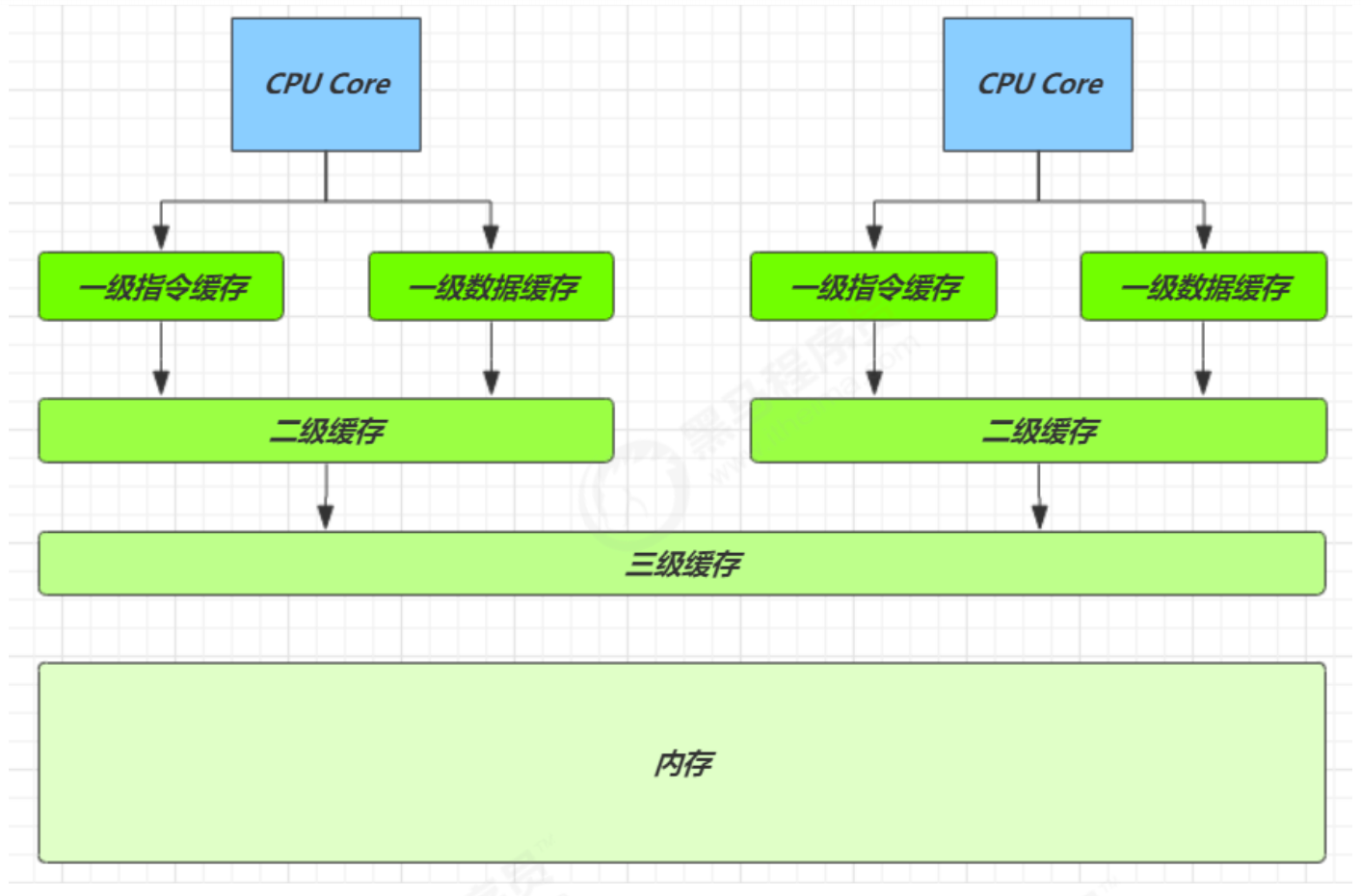

因为 CPU 与 内存的速度差异很大,需要靠预读数据至缓存来提升效率。
而缓存以缓存行为单位,每个缓存行对应着一块内存,一般是 64 byte(8 个 long)
缓存的加入会造成数据副本的产生,即同一份数据会缓存在不同核心的缓存行中
CPU 要保证数据的一致性,如果某个 CPU 核心更改了数据,其它 CPU 核心对应的整个缓存行必须失效
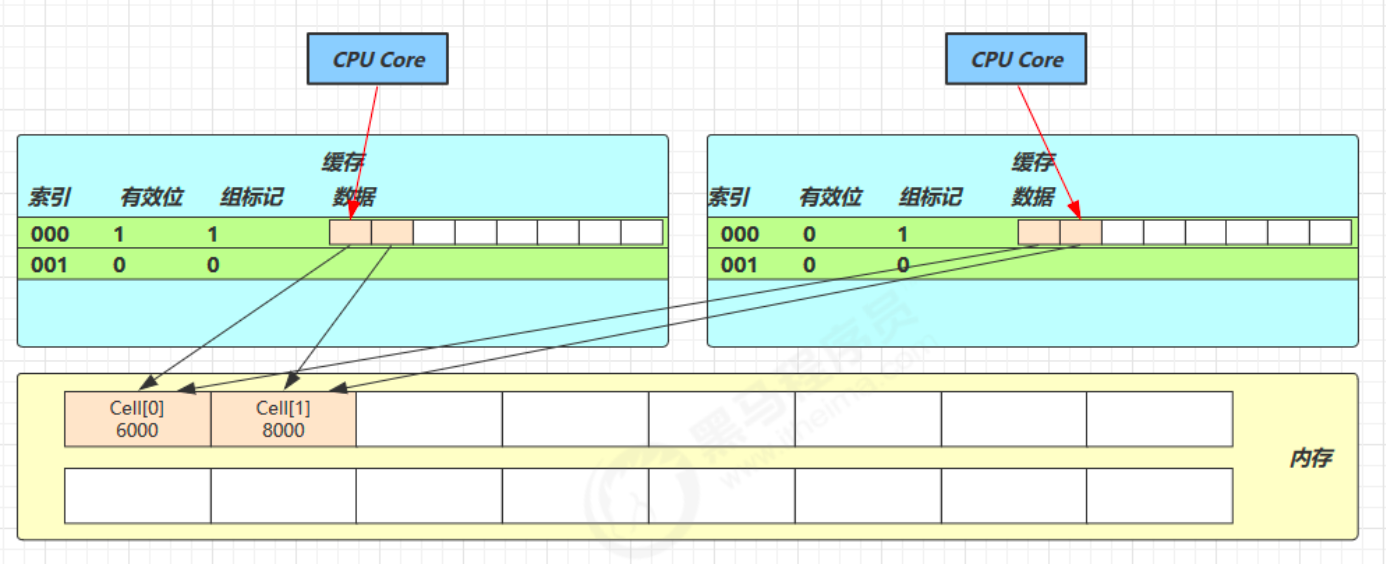
因为 Cell 是数组形式,在内存中是连续存储的,一个 Cell 为 24 字节(16 字节的对象头和 8 字节的 value),因此缓存行可以存下 2 个 Cell 对象。这样问题来了:
- Core-0 要修改 Cell[0]
- Core-1 要修改 Cell[1]
- 一个 Core 对应一个线程,一个线程负责修改一个 Cell。
无论谁修改成功,都会导致对方 Core 的缓存行失效,比如 Core-0 中Cell[0]=6000, Cell[1]=8000要累加Cell[0]=6001, Cell[1]=8000,这时会让 Core-1 的缓存行失效
@sun.misc.Contended 用来解决这个问题,它的原理是在使用此注解的对象或字段的前后各增加 128 字节大小的 padding,从而让 CPU 将对象预读至缓存时占用不同的缓存行,这样,不会造成对方缓存行的失效。
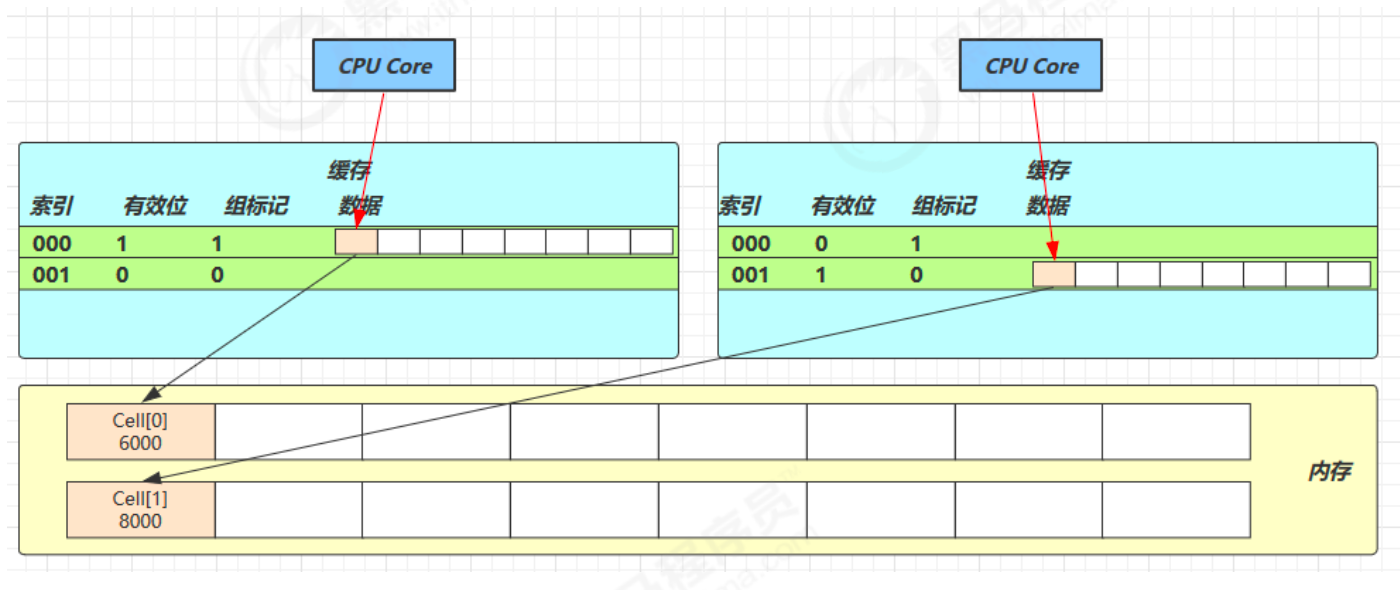
累加主要调用下面的 add 方法:
java
public class LongAdder extends Striped64 implements Serializable {
private static final long serialVersionUID = 7249069246863182397L;
/**
* Creates a new adder with initial sum of zero.
*/
public LongAdder() {
}
/**
* Adds the given value.
*
* @param x the value to add
*/
public void add(long x) {
// as 为累加单元数组
// b 为基础值
// x 为累加值
Cell[] as; long b, v; int m; Cell a;
// 进入 if 的两个条件
// 1. as 有值, 表示已经发生过竞争, 进入 if
// 2. cas 给 base 累加时失败了, 表示 base 发生了竞争, 进入 if
// base 是父类 Striped64 中的 volatile 变量
// base:基值,主要在无争用时使用,但也在表初始化竞争期间用作回退。通过 CAS 更新。
// casBase:父类方法
if ((as = cells) != null || !casBase(b = base, b + x)) {
// uncontended 表示 cell 没有竞争
boolean uncontended = true;
// as 还没有创建
if (as == null || (m = as.length - 1) < 0 ||
// 当前线程对应的 cell 还没有
(a = as[getProbe() & m]) == null ||
// cas 给当前线程的 cell 累加失败 uncontended=false (a为当前线程的cell)
!(uncontended = a.cas(v = a.value, v + x)))
// 进入 cell 数组创建、cell 创建的流程
longAccumulate(x, null, uncontended);
}
}
}add 流程图:

java
abstract class Striped64 extends Number {
// CPU 数量,要限制 Cell 数组的大小
static final int NCPU = Runtime.getRuntime().availableProcessors();
// Cell 数组。当非 null 时,size 是 2 的幂
transient volatile Cell[] cells;
// 基值,主要在无争用时使用,但也在表初始化竞争期间用作回退。通过 CAS 更新。
transient volatile long base;
// 调整大小和/或创建 Cell 数组时使用的自旋锁(通过 CAS 锁定)
transient volatile int cellsBusy;
final boolean casBase(long cmp, long val) {
return UNSAFE.compareAndSwapLong(this, BASE, cmp, val);
}
final void longAccumulate(long x, LongBinaryOperator fn,
boolean wasUncontended) {
int h;
// 当前线程还没有对应的 cell, 需要随机生成一个 h 值用来将当前线程绑定到 cell
if ((h = getProbe()) == 0) {
// 初始化 probe
ThreadLocalRandom.current(); // force initialization
// h 对应新的 probe 值, 用来对应 cell
h = getProbe();
wasUncontended = true;
}
// collide 为 true 表示需要扩容
boolean collide = false; // True if last slot nonempty
for (;;) {
Cell[] as; Cell a; int n; long v;
// 已经有了 cells
if ((as = cells) != null && (n = as.length) > 0) {
// 还没有 cell
if ((a = as[(n - 1) & h]) == null) {
// 为 cellsBusy 加锁, 创建 cell, cell 的初始累加值为 x
// 成功则 break, 否则继续 continue 循环
if (cellsBusy == 0) { // Try to attach new Cell
Cell r = new Cell(x); // Optimistically create
if (cellsBusy == 0 && casCellsBusy()) {
boolean created = false;
try { // Recheck under lock
Cell[] rs; int m, j;
if ((rs = cells) != null &&
(m = rs.length) > 0 &&
rs[j = (m - 1) & h] == null) {
rs[j] = r;
created = true;
}
} finally {
cellsBusy = 0;
}
if (created)
break;
continue; // Slot is now non-empty
}
}
collide = false;
} // 有竞争, 改变线程对应的 cell 来重试 cas
else if (!wasUncontended) // CAS already known to fail
wasUncontended = true; // Continue after rehash
// cas 尝试累加, fn 配合 LongAccumulator 不为 null, 配合 LongAdder 为 null
else if (a.cas(v = a.value, ((fn == null) ? v + x :
fn.applyAsLong(v, x))))
break;
// 如果 cells 长度已经超过了最大长度, 或者已经扩容, 改变线程对应的 cell 来重试 cas
else if (n >= NCPU || cells != as)
collide = false; // At max size or stale
// 确保 collide 为 false 进入此分支, 就不会进入下面的 else if 进行扩容了
else if (!collide)
collide = true;
// 加锁
else if (cellsBusy == 0 && casCellsBusy()) {
// 加锁成功, 扩容
try {
if (cells == as) { // Expand table unless stale
Cell[] rs = new Cell[n << 1];
for (int i = 0; i < n; ++i)
rs[i] = as[i];
cells = rs;
}
} finally {
cellsBusy = 0;
}
collide = false;
continue; // Retry with expanded table
}
// 改变线程对应的 cell
h = advanceProbe(h);
}
// 还没有 cells, 尝试给 cellsBusy 加锁
else if (cellsBusy == 0 && cells == as && casCellsBusy()) {
// 加锁成功, 初始化 cells, 最开始长度为 2, 并填充一个 cell
boolean init = false;
try { // Initialize table
if (cells == as) {
Cell[] rs = new Cell[2];
rs[h & 1] = new Cell(x);
cells = rs;
init = true;
}
} finally {
cellsBusy = 0;
}
// 成功则 break;
if (init)
break;
}
// 上两种情况失败, 尝试给 base 累加
else if (casBase(v = base, ((fn == null) ? v + x :
fn.applyAsLong(v, x))))
break; // Fall back on using base
}
}
}longAccumulate 流程图


每个线程刚进入 longAccumulate 时,会尝试对应一个 cell 对象(找到一个坑位)

获取最终结果通过 sum 方法
java
public long sum() {
Cell[] as = cells;
Cell a;
long sum = base;
if (as != null) {
for (int i = 0; i < as.length; ++i) {
if ((a = as[i]) != null)
sum += a.value;
}
}
return sum;
}Unsafe
概述
Unsafe 对象提供了非常底层的,操作内存、线程的方法,Unsafe 对象不能直接调用,只能通过反射获得
java
public class UnsafeAccessor {
static Unsafe unsafe;
static {
try {
Field theUnsafe = Unsafe.class.getDeclaredField("theUnsafe");
theUnsafe.setAccessible(true);
unsafe = (Unsafe) theUnsafe.get(null);
} catch (NoSuchFieldException e) {
throw new RuntimeException(e);
} catch (IllegalAccessException e) {
throw new RuntimeException(e);
}
}
static Unsafe getUnsafe() {
return unsafe;
}
}Unsafe CAS 操作
java
@Data
class Teacher {
volatile int id;
volatile String name;
}
class TestUnsafe {
public static void main(String[] args) throws NoSuchFieldException {
Unsafe unsafe = UnsafeAccessor.getUnsafe();
Field id = Teacher.class.getDeclaredField("id");
Field name = Teacher.class.getDeclaredField("name");
// 获得成员变量的偏移量(可以理解为该成员变量相对于对象在内存中的偏移地址)
long idOffset = unsafe.objectFieldOffset(id);
long nameOffset = unsafe.objectFieldOffset(name);
Teacher t = new Teacher();
// 使用 cas 方法替换成员变量的值
unsafe.compareAndSwapInt(t, idOffset, 0, 20);
unsafe.compareAndSwapObject(t, nameOffset, null, "张三");
System.out.println(t);
}
}输出
java
Teacher(id=20, name=张三)使用自定义的 AtomicData 实现之前线程安全的原子整数 Account 实现
java
public class AtomicData {
private volatile int data;
static final Unsafe unsafe;
static final long DATA_OFFSET;
static {
unsafe = UnsafeAccessor.getUnsafe();
try {
// data 属性在 DataContainer 对象中的偏移量,用于 Unsafe 直接访问该属性
DATA_OFFSET = unsafe.objectFieldOffset(AtomicData.class.getDeclaredField("data"));
} catch (NoSuchFieldException e) {
throw new RuntimeException(e);
}
}
public AtomicData(int data) {
this.data = data;
}
public void decrease(int amount) {
int oldValue;
while(true) {
// 获取共享变量旧值
oldValue = data;
// cas 尝试修改 data 为 oldValue - amount,如果期间旧值被别的线程修改了,返回 false
if(unsafe.compareAndSwapInt(this, DATA_OFFSET, oldValue, oldValue - amount)){
return;
}
}
}
public int getData() {
return data;
}
}Account 实现
java
class TestAtomicData {
public static void main(String[] args) {
Account.demo(new Account() {
AtomicData atomicData = new AtomicData(10000);
@Override
public Integer getBalance() {
return atomicData.getData();
}
@Override
public void withdraw(Integer amount) {
atomicData.decrease(amount);
}
});
}
}